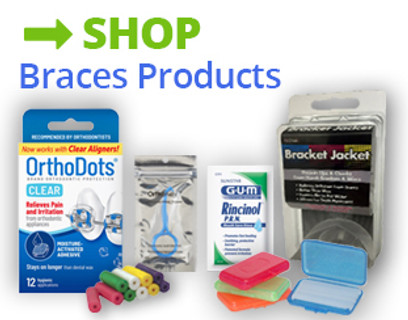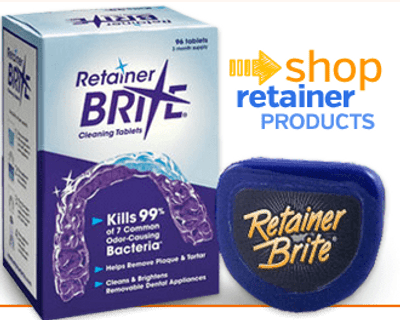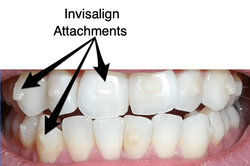All About Invisalign Attachments
At some point in your Invisalign treatment, you might need Attachments to move your teeth into their proper positions. Whether you expected to get them or not, they are a little something extra that you will need to learn to deal with during your orthodontic treatment with Invisalign. Some people need Attachments and others do not. This is because your Invisalign treatment is customized by your orthodontist for your specific case.
Most simple cases of tooth movement don’t require attachments during Invisalign treatment. But if you have a moderate to advanced case (including issues such as gaps, extreme crowding, or teeth that need to be rotated), attachments may be necessary. The attachments give the Invisalign trays a little something extra to grip as they guide your teeth into their new positions.
Try not to be upset if you learn that you’ll need attachments to move forward with your treatment. Your orthodontist wouldn’t prescribe them unless they were necessary to properly achieve your desired results. Just as traditional braces require certain accessories to accomplish specific goals, Invisalign attachments are required to move your treatment forward.
What Are Invisalign attachments & What Are They Made From?
Invisalign attachments are specifically shaped bumps made from a tooth-colored material called composite resin (the same strong material used in fillings and cosmetic tooth bonding). Based on your treatment plan and your progress, the attachments are placed at specific positions directly on specific teeth. An orthodontist might use them for certain types of movements such as rotations, extrusions, or intrusions. These types of movements require more power or torque than your Invisalign trays can provide alone.
Some patients may have multiple attachments placed on one tooth. Sometimes it’s necessary to apply an entirely new set of attachments to move your treatment forward. This is most common near the end of treatment, when your orthodontist is doing refinements. Attachments can wear out over time and need to be replaced. Tell your orthodontist if you feel like one has chipped or worn down significantly.
Buttons and Bite Ramps
Buttons and Bite Ramps are other types of Invisalign attachments, usually built into the aligners themselves.
Buttons are small hooks affixed directly to the aligners. Like the metal hooks on traditional braces, buttons anchor elastic bands that link positions on your top and bottom jaws. The positions and force of the elastics help close up an open bite, or correct other misalignments between the top and bottom teeth and jaws.
Bite Ramps (sometimes called “bumps”) are specifically placed buildups manufactured into the plastic aligner to help open your bite vertically. In traditional braces, this type of appliance is known as a Bite Turbo.
How Do Invisalign Attachments Feel?
Invisalign attachments may feel uncomfortable during the first few days for a variety of reasons. First, you are not used to feeling the accessory on your teeth or on your trays; it takes time to get used to them being there. Secondly, the attachments help to provide more force or torque to your teeth, and you might not be used to the new feelings of pressure. The more you wear your aligners, the faster you’ll get used to the discomfort. Most people adjust to their attachments within a few days.
If the attachments are causing irritations or sores inside your mouth, try using OrthoDots to smooth out the rough spots. Unlike regular dental wax or dental silicone, OrthoDots will firmly stick to Invisalign attachments and Invisalign trays. They come in boxes of 12 and boxes of 48.
Ramp Up Your Hygiene
Attachments are great hiding places for small bits of food or bacteria. Make sure that you brush and floss your teeth daily and pay extra attention to the areas around your attachments. Spend extra time brushing in those areas or concentrate on them when using your oral irrigator. Coffee, mustard, curry and red wine may slightly stain your Invisalign attachments, so you might want to avoid them or eat them sparingly. Most patients report that there’s no way to remove these stains (whitening toothpaste, baking soda, or tooth whiteners don’t work on them). Take some solace in knowing that the slight stains won’t be very noticeable beneath your Invisalign trays.
Can I Remove Attachments Myself?
Under no circumstances should you attempt to remove attachments yourself! Special orthodontic tools are required to remove the attachments, and if you try to do it yourself you risk damaging your teeth. If something about your attachments is bothering you, speak to your orthodontist before attempting to remedy it yourself.
Keep Smiling!
-Lynn
About The Author
Lynn S. is the founder and owner of DentaKit.com. Shortly after getting braces in 2001 at age 41, Lynn realized that there was no convenient way for her to find the orthodontic products she needed locally. She created DentaKit.com to give orthodontic patients easy access to products that would help keep their braces and retainers clean and comfortable. Along the way, she also created ArchWired.com and its Metal Mouth Message Board to provide vital information and an online community for adults who have orthodontic braces.
Lynn S. has a degree in Communications and Journalism, with a focus on scientific writing and research. Before founding DentaKit.com, she was a technical writer and technical trainer for various high-tech companies in Silicon Valley. Since starting DentaKit.com 15+ years ago, she has attended many meetings of various dental associations, and has read and researched extensively on a variety of orthodontic and dental subjects. The articles she writes are always vetted by one or more orthodontists or dentists before they are published.



